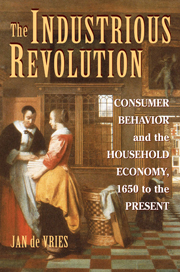Book contents
- Frontmatter
- Contents
- List of Figures
- Preface and Acknowledgments
- 1 The Transformation of Consumer Desire in the Long Eighteenth Century
- 2 The Origins of the Industrious Revolution
- 3 The Industrious Revolution: The Supply of Labor
- 4 The Industrious Revolution: Consumer Demand
- 5 The Breadwinner–Homemaker Household
- 6 A Second Industrious Revolution?
- Bibliography
- Index
6 - A Second Industrious Revolution?
Published online by Cambridge University Press: 05 June 2012
- Frontmatter
- Contents
- List of Figures
- Preface and Acknowledgments
- 1 The Transformation of Consumer Desire in the Long Eighteenth Century
- 2 The Origins of the Industrious Revolution
- 3 The Industrious Revolution: The Supply of Labor
- 4 The Industrious Revolution: Consumer Demand
- 5 The Breadwinner–Homemaker Household
- 6 A Second Industrious Revolution?
- Bibliography
- Index
Summary
In the twentieth century all this would change. Upper-class foreshadowings early in the century became a broadly based social trend after the 1950s, questioning both the value of the common goods provided by the breadwinner–homemaker household and the justice and rationality of the division of labor on which the production of those goods depended. A new industrious revolution emerged in whose grip we continue to live today.
Similarities and Differences
The basic facts are familiar. Expressed in the terms of the household models used in this study, the past generation has witnessed (1) a vast expansion of the number of households with multiple earners, (2) a pronounced redeployment of labor time from household to market production, (3) the introduction of consumption technologies that are much less intensive in their use of household labor, (4) reduced income pooling, and (5) the shift of consumer preferences toward services, public consumption, and individuated consumption. Each of these features has parallels in the industrious revolution of the long eighteenth century and involves the household in similar decisions about consumption objectives and the means to achieve them.
Yet, these similarities notwithstanding, it is obvious that the modern context of household decision making differs significantly from that in the centuries before 1850. To begin with, the state now encroaches on household decisions far more than in the past.
- Type
- Chapter
- Information
- The Industrious RevolutionConsumer Behavior and the Household Economy, 1650 to the Present, pp. 238 - 274Publisher: Cambridge University PressPrint publication year: 2008



